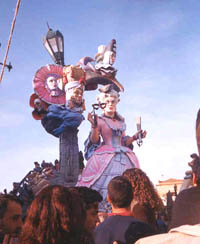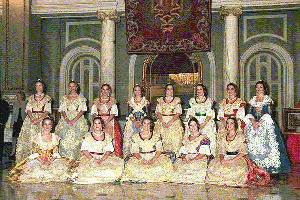
by Susana Hernßndez and Javier Rivate

They are of the most important festival in Spain. They are celebrated on the feast of San Jose, from the 12th until the 19th of March.
Valencia is a beautiful city a great harbour on the Mediterranean sea and famous for its medieval and renaissance architecture. A very good museum has just been inaugurated.
At the Museum
It's surrounded by very fertile fields, so rich that valencian people called this place "the paradise on earth". It's also known for it "paella" on exquisite dish made with rice, vegetables and see food.
The origin of the fallas goes back to the pagan bonfires to commemorate the beginning of spring and to pay homage to the god Saturn.
In the 16th century, the guild of carpenter used to celebrate the end of winter on the day of their patron saint, San Josķ. They did it, burning the useless remains of all the wood used throughout the year. Platforms near the walls where some dolls called "ninots" were displayed. They satirized especial events, behaviour or people. They were dressed with all clothes to be burnt
afterwards.
These satirical "fallas" used to be accompanied with poems, hange on the walls and describing the story represented by the
"fallas".
To prevent fires, they were planed in the middle of the main squared or in the crossroads, and this gave rise to the origin the "fallas". Valencian people make them throughout years. They were made of cardboard, plaster
Falla cast, wax, wood and weare netting; decorations were added so that they should not look like human beings. Painting the wax is one of the most difficult
tasks.
They are huge figures (event 20m tall and they weigh about 8 and 10 tons) made up of cardboard figures describing grotesque and humorous scenes, satirizing politicians, actors and actresses, bullfighters and well known people about 370 big "fallas" and 368 small ones for the children, are make every
year.
On the night of 15th of march, they are placed in the main squares and the crossroads. They are terrific, imposing, suggestive and can be seen from a
distance.
The valencian girls who reign over the celebrations are called "falleras". They were colourful, typical costumers, made of silk and very well embroidered. they embellish themselves with old jewels. The festival starts with the procession of the
"ninots".
There are groups of people in fancy dresses who criticize the special events of the years.
Falleras 
Another important ceremony in the offering of flowers to the Virgin, the patroness of Valencia, called the virgin of the
Forsaken.
Finally there is "la nuit del foc" that means the fire night, when a lot of bonfires are it.
It's a farewell ceremony.
|
|
|
The town bursts in to flames and the sky is covered with fireworks ( cremß)
Susana, years ago
